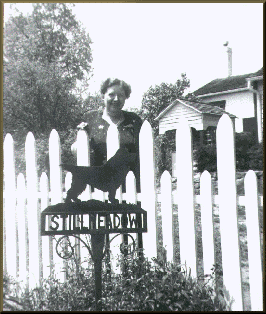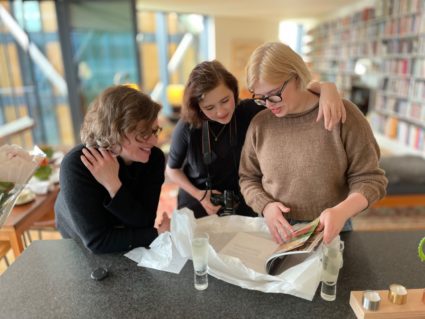cooking from a legend

It’s proving daunting.
I’m really trying hard these days to plow through the hundreds and hundreds of Gladys Taber recipes, to choose the absolute best in all the myriad categories, to test, update possibly, and surround with some meaningful verbiage. She cooked so much! And I have to say, as I’ve said before, that many of the recipes are dated to the point of being fun to read, as perhaps fiction, but not something you would ever want to cook. The dire words “dried” and “chipped” often appear in a single sentence, sometimes followed even more depressingly by “beef.” And the things that appeared in tins in the 1940s, to follow the unsuspecting cook home from the supermarket and take up residence on her pantry shelves, there to sit menacingly until used in some way on her innocent family. Canned sausages! Canned oysters! The things she thought to grind up, mix with gelatine and sour cream, and bake into one sort of “loaf” or another. Everything designed for minimum cost and maximum fillingness. And ways to use leftovers that nearly always involve a can of cream of mushroom soup. Plus turkey with spaghetti! What? And I adore any recipe that includes the word “mock.”
And some of the reading is enjoyable purely on a vocabulary level. It took me a moment to realize that “edible-podded peas” were not something from Star Trek, but rather what was called in my childhood “peapods” (appearing only at the Hong Kong Chinese restaurant, never at home), and are now called “snowpeas” in America and “mange tout” in England.
What really shines through the writing, underneath the recipes, is her boundless hospitality. How many dishes had to be invented from what she had on hand because someone dropped in unannounced and fully expected to be fed? And she did. “Baked Noodle Ring,” “Cheese Dreams” and “Mrs. Bewlay’s Rhubarb Crusty.” Somehow I think the substitution of the word “crumble” for “crusty” would better convey a thing to eat than, say, a medical condition.
Oh, and if you feel in need of a laugh, here is a completely hilarious website containing Weight Watchers food photographs from the 1960s, dishes like “Fluffy Mackerel Pudding,” with captions like “Once upon a time the world was young and the words “mackerel” and “pudding” existed far, far away from one another. One day, that all changed. And then, whoever was responsible somehow thought the word fluffy would help…” Reminds me of the cookbook published by the association at the lake where we had a summer house. I am absolutely positive there was a dish called “Twinkie Tuna Seven-up Bake.” Really!
In any case, last night found me staring at a container of chicken livers I bought in a moment of weakness at the farmer’s market on Sunday. Organic, free-range, you name it. About a half pound, I think. What to do? Then into my mind snaked the memory of a Christmas Eve party at Red Gate Farm several years ago to which I invited Anne and David of Stillmeadow (Gladys Taber’s beloved farmhouse), our farmer friends Rollie and Judy, and both our sets of parents happened to be visiting. My mother-in-law and I spent the afternoon concocting various party foods from the Stillmeadow Cookbook, including a lovely cucumber dip, and… chicken liver pate! My clever mummy made hand-calligraphied menu cards for the table, and with many, many candles lit and glasses of wine poured, the fun began. And the pate was so good. I really felt Gladys’ spirit would have been pleased, to see us all enjoying the Connecticut winter with a nice neighborly party, and with her food to bring us together.
So I made the pate again last night, while John read his newspaper in the kitchen to keep me company, and Avery laboriously glued rhinestones on her skates to celebrate Level 10. A cosy evening together, and the taste of Madeira-laced chicken livers in butter did not disappoint. Give it a try.
Gladys Taber’s Chicken Liver Pate
(serves many at a party, on toast)
1/2 lb fresh chicken livers
1 medium white onion, sliced
4 tbsps butter
about 1/2 cup Madeira wine
salt and pepper to taste
In two separate skillets, divide the butter and melt gently. Saute the onion in one skillet and the liver in another, taking care not to brown either skillet. Just sweat them gently. After about five minutes, they will be cooked through and can be combined in your food processor. Add the Madeira and whizz until as smooth as possible. Add more Madeira if the texture is too thick. Salt and pepper to taste, and then if you insist on a purely smooth pate, you can run the mixture through a sieve. Enjoy this affordable and generous post-War treat.


